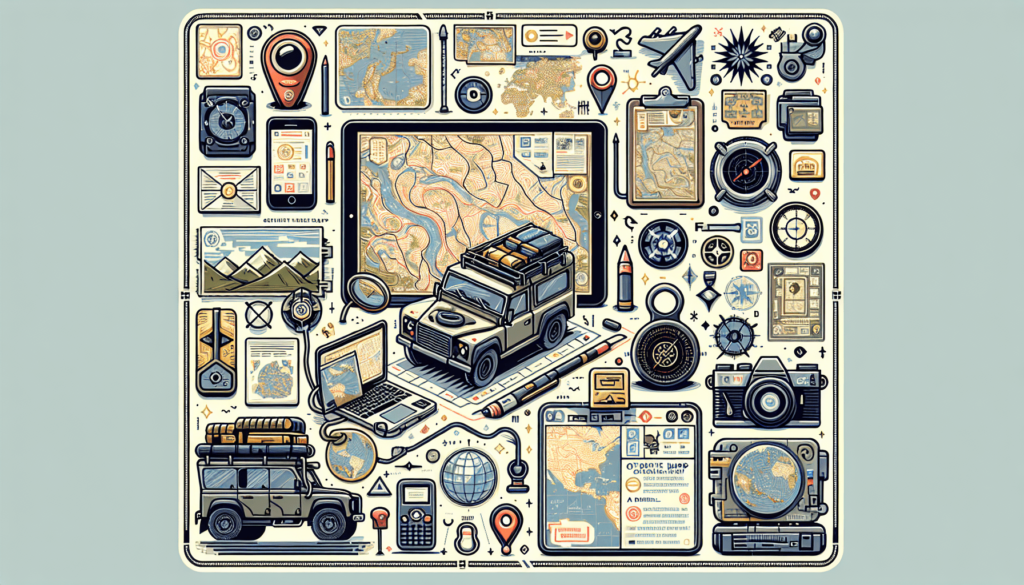Are you an adventurer at heart, constantly seeking new destinations to explore? If so, you’ve probably wondered about the best maps to guide you on your overland travel expeditions. Picking the right map can make all the difference in ensuring a smooth and memorable journey. Whether you’re embarking on a cross-country road trip or venturing into uncharted territories, this article will unveil the top maps that will be your trusty companions on your next thrilling adventure.

Topographic Maps
Definition
Topographic maps are detailed and accurate representations of the Earth’s surface, showcasing both natural and man-made features. These maps use contour lines to represent elevation and provide valuable information about the land’s shape and characteristics. They are typically used for outdoor activities such as hiking, camping, and mountaineering.
Features
Topographic maps display a range of features, including but not limited to rivers, lakes, mountains, forests, roads, and buildings. These maps also provide information on land relief through contour lines, which indicate changes in elevation. Furthermore, they often include geographic coordinates, scale bars, and legends that explain the symbols and colors used in the map.
Advantages
Topographic maps offer several advantages for overland travel. Firstly, their detail and accuracy make them invaluable for navigating challenging terrains, as they display the topography of an area in great detail. Secondly, these maps can be used offline, making them ideal for areas with limited or no internet access. Additionally, topographic maps are highly durable and can withstand rugged outdoor conditions.
Disadvantages
While topographic maps provide extensive information, they may be overwhelming for beginners or those unfamiliar with map reading. The use of contour lines and symbols requires some level of knowledge and understanding. Furthermore, these maps can be quite large and take up space in backpacks or travel gear. Additionally, they do not provide real-time information, so changes in the landscape or infrastructure may not be reflected on the map.
Road Atlases
Definition
Road atlases are comprehensive collections of maps that specifically focus on roads and highways. These atlases provide detailed coverage of entire regions or countries, highlighting major and minor road networks, along with points of interest such as gas stations, rest areas, and attractions. Road atlases are commonly used for navigation during road trips and long-distance travel.
Features
Road atlases contain numerous pages of maps, organized by states, regions, or countries, depending on their scope. They often include an index or table of contents for easy reference and navigation. The maps in these atlases display road networks with different classifications (e.g., highways, secondary roads), landmarks, and points of interest. Additionally, they may include distance charts, travel tips, and other useful information.
Advantages
Road atlases offer several advantages for overland travel. Firstly, their focus on road networks makes them particularly useful for long-distance trips by car or motorcycle, providing clear directions and alternative routes. Secondly, they are available in physical form, allowing for easy navigation without the need for electronic devices or an internet connection. Lastly, road atlases often include additional information like town maps and tourist attractions, making them helpful for planning stops along the way.
Disadvantages
Despite their benefits, road atlases have certain limitations. As physical maps, they can be bulky, making them less convenient for backpackers or travelers with limited space. Additionally, they may not always reflect recent changes in road layouts, such as new bypasses or infrastructure developments. Road atlases also lack real-time traffic information, so unexpected delays or road closures may not be accounted for.
GPS Navigation Systems
Definition
GPS navigation systems, also known as GPS devices or GPS units, are electronic devices that utilize Global Positioning System (GPS) technology to provide real-time location data, mapping, and directions. These devices typically use satellite signals to determine precise locations and offer turn-by-turn navigation instructions.
Features
GPS navigation systems come with a variety of features to aid travelers in reaching their destinations. They include detailed maps, both in 2D and 3D perspectives, with voice-guided directions. These devices often have touchscreen interfaces for easy interaction and allow users to input specific destinations or search for points of interest. Some GPS systems also provide traffic updates, alternative route suggestions, and even integration with smartphones for additional functionality.
Advantages
GPS navigation systems offer several advantages for overland travel. Firstly, they provide real-time guidance, ensuring accurate directions based on the most up-to-date information. This can be particularly beneficial when navigating through unfamiliar areas or encountering unexpected road conditions. Secondly, GPS devices are portable and can be easily mounted in vehicles or carried while hiking. Lastly, these systems often offer features like traffic updates, estimated time of arrival, and points of interest, enhancing the overall travel experience.
Disadvantages
While GPS navigation systems are widely used and dependable, they are not without limitations. Firstly, these devices rely on satellite signals, which can be affected by tall buildings, dense tree cover, or other obstructions. As a result, they may experience signal loss and provide inaccurate location data. Secondly, GPS devices require power, whether through batteries or car chargers, making them dependent on a reliable power source. Lastly, regular updates are needed to ensure the maps and software are current, which may come at an additional cost.
Satellite Imagery
Definition
Satellite imagery involves capturing images of the Earth’s surface from satellites orbiting the planet. These images provide a bird’s-eye view of the landscape and offer valuable information about terrain, vegetation, bodies of water, and man-made structures. Satellite imagery is widely used in various fields, including mapping, environmental monitoring, and urban planning.
Features
Satellite imagery provides high-resolution images of different parts of the Earth. These images can be viewed on digital platforms or printed for offline use. Satellite images often showcase detailed perspectives of areas, allowing users to analyze land features, measure distances, and plan routes. Additionally, satellite imagery enables users to observe changes in the landscape over time, making it useful for long-term planning or studying environmental shifts.
Advantages
Satellite imagery offers several advantages for overland travel. Firstly, it provides a comprehensive overview of an area, allowing travelers to assess the terrain, vegetation, and other features before embarking on a journey. This can be particularly helpful for outdoor adventurers and hikers, as they can plan routes based on visual information. Satellite imagery also allows for virtual exploration of remote and inaccessible regions, giving travelers a better understanding of the area they plan to explore.
Disadvantages
While satellite imagery is a valuable tool, it does have some limitations. Firstly, the quality of satellite images can vary depending on the resolution and the presence of cloud cover. Poor image quality or obscured details can make it challenging to discern certain features accurately. Additionally, satellite images may not provide real-time data, as the imaging process takes time and images are generally not updated daily. This means that recent changes in the landscape may not be reflected in the imagery.

Mobile Applications
Definition
Mobile applications, or apps, for mapping and navigation are software programs designed to run on mobile devices such as smartphones and tablets. These apps utilize built-in GPS capabilities to provide real-time location services, mapping, and guidance. With a wide range of mapping apps available today, users can choose from various options based on their specific travel needs.
Features
Mapping apps offer a diverse set of features to assist travelers. They typically include interactive maps with different viewing options, including 2D and 3D perspectives, and the ability to zoom in and out for detailed exploration. These apps provide turn-by-turn navigation instructions, often with voice guidance, and the ability to search for specific addresses or points of interest. Some apps also offer additional features like offline maps, real-time traffic information, and integration with other travel tools.
Advantages
Mobile mapping apps offer numerous advantages for overland travel. Firstly, they are highly convenient, as most people already carry smartphones or tablets with them. This eliminates the need for additional devices or carrying physical maps. Secondly, mapping apps provide real-time updates and directions based on the most recent data, taking into account factors like traffic conditions. This ensures accurate guidance and the ability to adapt to unexpected changes. Lastly, these apps often offer a user-friendly interface with additional features like integration with social media or the ability to save favorite locations, enhancing the overall travel experience.
Disadvantages
Despite their convenience, mobile mapping apps have certain drawbacks. Firstly, they rely on a stable internet connection or pre-downloaded maps for offline use. This can be problematic in areas with limited or no network coverage, such as remote wilderness or foreign countries. Secondly, heavy usage of mapping apps can drain the battery life of mobile devices, making it necessary to have backup power sources. Additionally, digital maps may lack the level of detail provided by physical maps or topographic maps, particularly when it comes to terrain features.
Online Mapping Platforms
Definition
Online mapping platforms refer to websites or web-based applications that provide mapping and navigation services. These platforms allow users to access maps, satellite imagery, and other geographic data through internet browsers and are often free to use. Online mapping platforms have gained popularity due to their accessibility and the ability to access maps from various devices, including computers, tablets, and smartphones.
Features
Online mapping platforms offer an array of features to assist users in their travel endeavors. They provide interactive maps, similar to mobile apps, allowing for exploration and zooming in and out for detailed views. These platforms often include search functionalities, allowing users to find specific addresses, points of interest, or even routing options. Many online mapping platforms also allow users to create and save customized maps, add markers or annotations, and share maps with others.
Advantages
Online mapping platforms offer several advantages for overland travel. Firstly, they can be accessed from any internet-enabled device, eliminating the need for specific software or apps. This provides flexibility and convenience, as travelers can use their preferred device to access maps and plan routes. Secondly, online mapping platforms often provide access to a wide range of maps, including topographic maps, satellite imagery, and even historical maps, catering to various travel needs. Additionally, many of these platforms allow for collaboration, enabling users to share or collaborate on maps with others.
Disadvantages
While online mapping platforms are widely accessible and feature-rich, they do have some limitations. Firstly, they require a stable internet connection for smooth operation, which may be an issue in remote or rural areas with limited network coverage. Secondly, online maps rely on external servers and can be affected by server downtimes or slow loading times, potentially hindering navigation in real-time. Lastly, the reliance on internet connectivity means that travelers may not have access to maps or navigation capabilities in areas without network coverage.
Paper Maps
Definition
Paper maps refer to physical maps that are printed on paper or other durable materials. These maps include various types like topographic maps, road maps, and city maps, providing different levels of detail and specific information. Paper maps have been a staple in navigation for centuries and continue to be widely used today, offering a reliable and tangible source of guidance.
Features
Paper maps come in different sizes and formats, depending on their purpose. They typically display a wide range of information such as roads, landmarks, water bodies, and natural features. Some paper maps include contour lines to indicate elevation changes, while others may have additional information like campgrounds, hiking trails, or historical landmarks. These maps often have a legend or key explaining the symbols used on the map, enabling users to interpret the information accurately.
Advantages
Paper maps offer several advantages for overland travel. Firstly, they provide a tangible and tactile experience, allowing users to physically interact with the map. This can be particularly helpful when planning routes or gaining a spatial understanding of the area. Secondly, paper maps do not rely on power sources or internet connectivity, making them suitable for outdoor adventures or areas with limited technology access. Additionally, they offer a sense of reliability and serve as a backup in case of electronic device malfunctions or battery drain.
Disadvantages
While paper maps have their merits, they do have certain drawbacks. Firstly, paper maps can be bulky and take up space, making them less portable compared to digital alternatives. This can be a significant concern for backpackers or travelers who aim to minimize their load. Secondly, paper maps may not always reflect recent changes in infrastructure, road networks, or natural features, as they are published at specific intervals. This means that users should cross-reference their maps with other sources or consider the potential for outdated information.
Overland Travel Guidebooks
Definition
Overland travel guidebooks are comprehensive resources that provide travelers with detailed information, maps, and advice for multiple destinations. These guidebooks typically focus on a specific region or country and cover a wide range of topics, including culture, history, attractions, and transportation. Overland travel guidebooks serve as valuable companions for travelers seeking immersive experiences and in-depth knowledge about the places they visit.
Features
Overland travel guidebooks encompass a wealth of features to assist travelers in their journeys. They provide detailed maps that highlight key routes, attractions, and points of interest. These maps are often accompanied by descriptive text and suggested itineraries to help users plan their trips effectively. Guidebooks also include information on transportation options, accommodation recommendations, dining suggestions, cultural etiquette, and safety tips. Additionally, they may include supplemental materials such as phrasebooks, currency conversion tables, or useful contact numbers.
Advantages
Overland travel guidebooks offer numerous advantages for travelers seeking immersive and independent experiences. Firstly, they provide comprehensive and reliable information, offering valuable insights into the destinations, including historical facts, local customs, and off-the-beaten-path locations. Secondly, guidebooks often include detailed maps that are specifically designed for overland travel, covering both popular routes and lesser-known areas. This makes them particularly useful for road trips, self-guided hikes, or explorations of remote regions. Lastly, guidebooks allow for greater flexibility and spontaneity, as they provide travelers with the tools to create their own itineraries and tailor their experiences based on personal preferences.
Disadvantages
While overland travel guidebooks have numerous benefits, they also have certain limitations. Firstly, guidebooks have a limited shelf life, as they are typically updated every few years or when significant changes occur. This means that the information on attractions, services, or transport options may not always be current. Additionally, guidebooks may be bulky and add weight to luggage, especially when visiting multiple destinations. Lastly, guidebooks may not cater to individual travel styles or preferences, as they offer generalized recommendations and cannot account for personal interests or niche activities.
National Geographic Maps
Definition
National Geographic maps are high-quality, detailed maps produced by the National Geographic Society. These maps embody the society’s commitment to cartographic excellence and geographic education, offering accurate and visually appealing representations of the Earth’s surface. National Geographic maps cover a wide range of regions, including continents, countries, national parks, and even underwater areas.
Features
National Geographic maps boast exceptional cartographic design and attention to detail. They often feature vibrant colors, clear labeling, and rich topographic information to enhance the user’s understanding of the landscape. These maps provide a wealth of information, including political boundaries, highways, rivers, mountains, and other geographic features. Some National Geographic maps also include thematic layers like climate zones, population density, or protected areas, allowing users to explore various aspects of a region.
Advantages
National Geographic maps offer several advantages for overland travel. Firstly, they are renowned for their accuracy and cartographic excellence, ensuring that users have access to reliable information. Additionally, National Geographic maps are visually stunning, making them engaging and enjoyable to use. Furthermore, these maps cater to various needs, as they cover a wide range of scales and regions. They can be used for both general travel planning and in-depth exploration, providing a versatile tool for different travel purposes.
Disadvantages
While National Geographic maps are highly regarded, they come with certain limitations. Firstly, their high quality and extensive details often result in their larger size, making them less portable compared to compact maps. This can be a consideration for travelers looking to minimize their load or those embarking on outdoor activities. Secondly, National Geographic maps may be more expensive compared to other map options, reflecting their premium quality. This might be a factor for budget-conscious travelers or those who prefer more affordable alternatives.
Local and Regional Maps
Definition
Local and regional maps refer to maps specifically designed to cover smaller geographic areas, such as cities, towns, or specific regions within a country. These maps focus on providing detailed information about the local features, including streets, landmarks, attractions, and points of interest. Local and regional maps are particularly useful for urban exploration, short trips, or when navigating within specific areas.
Features
Local and regional maps encompass features that cater to the specific needs of travelers exploring confined areas. These maps typically display streets, buildings, parks, and major landmarks in great detail, allowing users to navigate through urban environments efficiently. They often provide clear labeling, indexes, and color-coding to assist users in finding specific locations or services. Some local and regional maps also include public transport information, parking areas, or additional tourist-oriented points of interest.
Advantages
Local and regional maps offer numerous advantages for travelers exploring urban areas or specific regions. Firstly, they provide a highly detailed depiction of the area, making it easy to navigate through the streets and find specific locations. This is particularly beneficial in cities where GPS signal may be affected by tall buildings or other obstructions. Secondly, local and regional maps are often compact and easily portable, making them convenient for travelers to carry around. Additionally, these maps are readily available for purchase in various outlets or can be obtained from tourist information centers.
Disadvantages
Despite their usefulness, local and regional maps have certain limitations. Firstly, they may not cover broader areas outside the defined region, limiting their utility for travelers on more extensive journeys. It may be necessary to switch to a different map or use additional resources when venturing beyond the covered area. Secondly, local and regional maps may not always reflect recent changes in urban infrastructure, road layouts, or points of interest. As cities and towns evolve, new roads or landmarks may not be accurately represented on the map.

